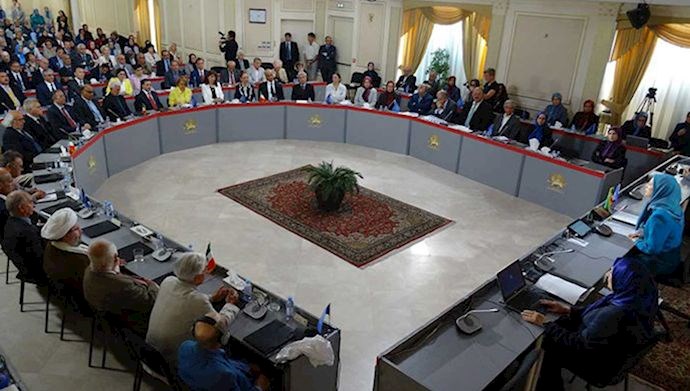On July 21, 1981, Iranian Resistance leader Massoud Rajavi announced the formation of the National Council of Resistance of Iran (NCRI), a coalition of democratic Iranian opposition groups dedicated to the mission of overthrowing the mullahs’ Velayat-e Faqih regime and establishing a pluralistic democracy in its place. Rajavi’s announcement in Tehran fell on the anniversary of the 1952 popular uprising against the Shah and in support of nationalist leader Dr. Mohammad Mossadeq and one month after mass executions of MEK members began.
Ten days after the announcement, Massoud Rajavi left Iran for Paris and set up the NCRI’s headquarters in Auvers-sur-Oise, north of Paris.
Provisional Government
At the beginning of 1982, the NCRI’s members drafted and adopted its constitution, platform, internal operational procedures, and immediate tasks for the provisional government. Once adopted, the documents were immediately published.
International dignitaries in Ashraf 3, home to members of the Iranian opposition group PMOI/MEK, express their support for the Iranian people’s struggle for freedom & democracy.#FreeIran#IStandWithMaryamRajavihttps://t.co/jM03o72vfQ
— People’s Mojahedin Organization of Iran (PMOI/MEK) (@Mojahedineng) July 12, 2019
The NCRI adopted a plan to form a provisional government to step in after the fall of the clerical regime. This government will consist of members of the NCRI’s 25 committees, all of whom are distinguished political figures who are well-qualified to serve in their respective fields. The provisional government will remain in place for six months, and their primary role will be to conduct free and fair elections and ensure the peaceful transfer of power to the representatives chosen by the Iranian people.
Elections for the “Constitutional and National Legislative Assembly” will be held no later than six months after the fall of the regime, and the provisional government would hand in its resignation to the Constitutional Assembly upon the formation of the Assembly.
The Constitutional Assembly will then draft Iran’s new constitution, appoint its government, and legislate its affairs until the constitution is adopted. The Constitutional Assembly will be in charge for no longer than two years.
Plans Adopted
Since its founding, the NCRI has adopted a number of plans for Iran’s democratic future. These include:
- The NCRI’s Peace Plan;
- the Plan for the Autonomy of Iranian Kurdistan;
- the Declaration on the Relations of the Provisional Government with Religion and Denominations; and
- the Plan on Rights and Freedoms of Women.
In 1993, the NCRI adopted a proposal to use the pre-Islamic Revolution Lion and Sun Persian tri-colored flag as their official emblem.
The NCRI also unanimously elected Mrs. Maryam Rajavi as the Council’s President in 1993. As President-elect, she will preside over the country and the provisional country during the six-month period after the mullahs are overthrown.
In 2002, the NCRI adopted the plan of the National Solidarity Front. The NCRI declared that it will cooperate with other willing political forces who are committed to the same goals. The National Solidarity Front welcomes all Iranians who completely reject the mullahs’ religious dictatorship and all of its various factions and seek to replace it with a democratic and independent republic based on a separation of Church and State.
Ashraf 3, home to members of the Iranian opposition group PMOI/MEK, stands as a beacon of hope for regime change in #Iran by the Iranian people for freedom, democracy and human rights.https://t.co/BUVcgv5VrG
— People’s Mojahedin Organization of Iran (PMOI/MEK) (@Mojahedineng) July 23, 2019
The NCRI’s platform includes firm commitments to abolishing the death penalty, protecting human rights, and ensuring that women have equal rights and protection. In 2005, Mrs. Maryam Rajavi stated, “In the free Iran of tomorrow, we will be committed to and defend the abolition of the death penalty and elimination of all forms of cruel punishments. We once again reiterate our commitment to the Convention against Torture, international humanitarian laws, and the Convention to Eliminate All Forms of Discrimination Against Women.”
Rep. Brad Sherman:
“Your fight is our fight I want to commend @Maryam_Rajavi for continuing her advocacy for democracy, women’s rights and minority rights in #Iran.”#FreeIran2018 #IStandWithMaryamRajavi pic.twitter.com/ETMRQzNEXc— People’s Mojahedin Organization of Iran (PMOI/MEK) (@Mojahedineng) July 20, 2018
Membership and Governance
The NCRI is the Iranian people’s parliament-in-exile. It has over 530 members, more than half of whom are women, and 25 committees.
The NCRI’s internal regulations state that Council meetings are official with 50 percent of members plus one. Decisions may be adopted with a simple majority.
The NCRI is religiously and ethnically diverse and includes representatives from groups that are often silenced in Iran. Kurds, Baluchis, Arabs, Persians, Turks, Turkomans, Muslims, Armenians, Jews, Zoroastrians, and atheists are all represented in the Council. Diversity in thought and persuasion are also embraced within the NCRI.
The NCRI’s membership is comprised of vibrant and talented people from a number of fields. Artists, writers, physicians, businessmen, bazaar merchants, university professors, military servicemen, athletes, politicians, scientists, and industrialists are among its representatives.





